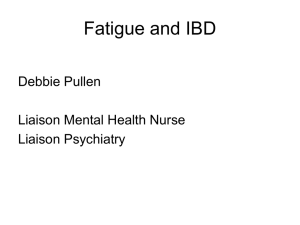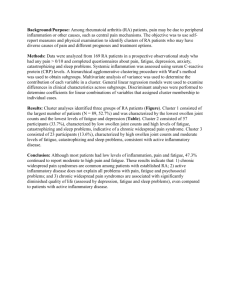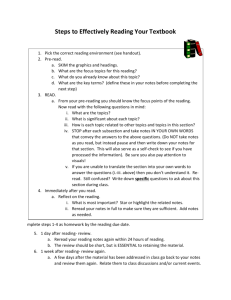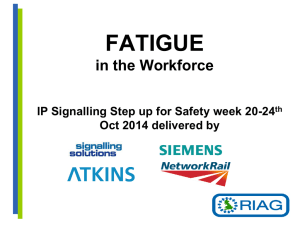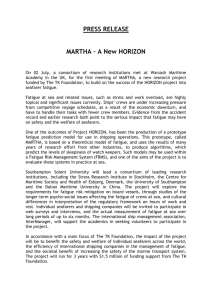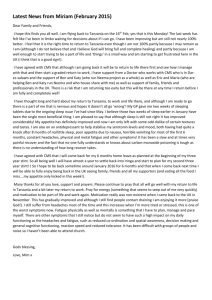Fatigue Risk Management Programme
advertisement
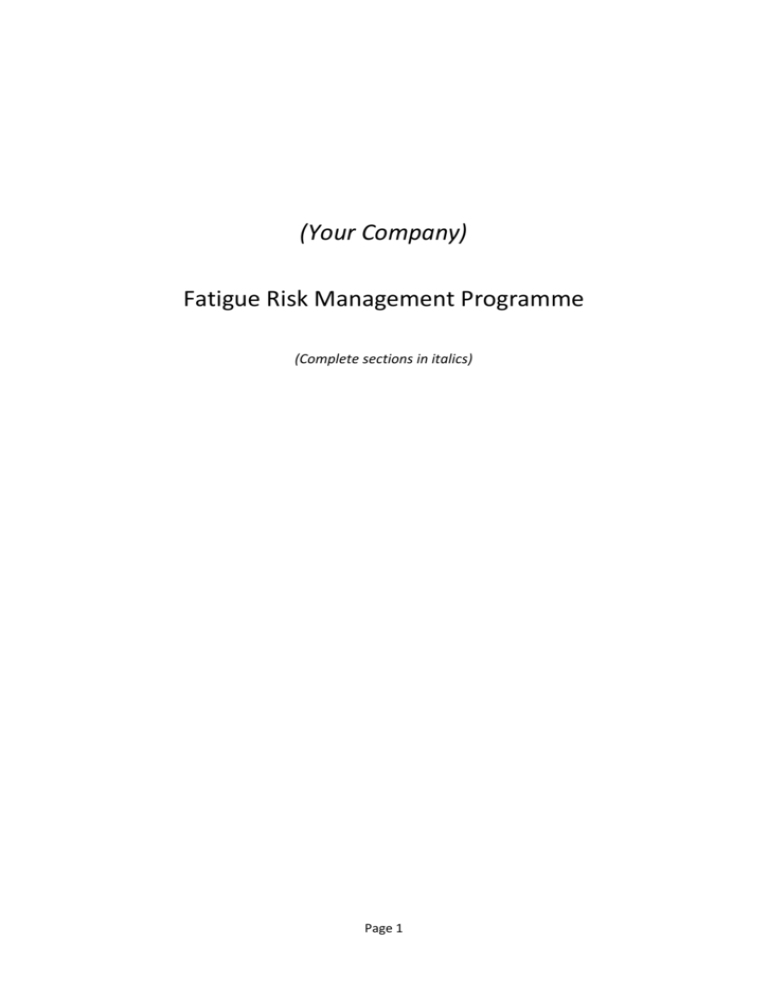
(Your Company) Fatigue Risk Management Programme (Complete sections in italics) Page 1 Foreword The work priorities of Ag operations present pilots with unique hazards, challenges, and constraints, some of which cannot be completely eliminated. For example, Ag pilots must manoeuvre their aircraft at very low altitude over terrain and must therefore accept an elevated risk of terrain and obstacle collisions, as well as having limited time to safely respond to an aircraft mechanical anomaly or recover from an inadvertent aerodynamic stall. Also, as a typically single-pilot operation, Ag flying places high demands on pilots’ attention. In addition to flying their aircraft, Ag pilots must operate their dispensing equipment and adjust their swath runs (often while monitoring in-cockpit resources such as GPS-aided precision aerial swathing equipment) to manage product drift and ensure quality coverage. They also must monitor the outside environment for a variety of considerations, such as weather phenomena (that can affect visibility or product drift), work area boundaries, obstacles, and areas to be avoided due to populations, noise abatement, livestock, or other safety considerations. Finally, seasonal work schedules, weather conditions, the potential for crop damage if a job is not completed, competition for contracts, and other factors can influence pilots’ or operators’ scheduling practices, creating demanding work schedules that pressure pilots to complete work within a certain period of time. These factors, separately or combined, can contribute to pilot fatigue and other performance-degrading effects. Ground crew necessarily have to be on the worksite at daylight and this often means they have to arise very early and drive there in the dark. Their working environment is usually noisy and it can be dusty and for some services the groundcrew will be exposed to hazardous substances. At the conclusion of the job they may have to return a loader to base or reposition it at another worksite. These factors, separately or combined, can contribute to ground crew fatigue and other performance-degrading effects. Page 2 Policy In (our company) we are dedicated to the health and safety of our staff and ourselves. Our objective is to have no serious harm accidents. We know that fatigue is a significant risk that we have to manage if we are to achieve our goal. We recognise that fatigue is subjective and is variable from one person to another so we have developed a Fatigue Risk Management Programme (FRM) that recognises the differences in people’s tolerance to fatigue. In some sectors, prescriptive rules are used to manage fatigue and an example of this is the trucking industry. Whilst this can be a valuable tool, our company believes that the process of fatigue assessment, by both management and the individual, is more effective at estimating levels of fatigue because it will pick up on the variables of each individual’s fatigue tolerance. The principle that our FRM follows is that everyone is responsible to look after themselves and everyone is responsible to look after their fellow workers. As a general rule we will encourage staff to have at least one day off every week and two consecutive days off every fortnight. A planned day off is not a day when you get up early and find the weather bad. A day off is a day you know you are having off at least two days prior. In line with our policy of continual improvement, (this company) will review the FRM Programme at each staff meeting and make changes to its requirements when these are indicated. We require all staff to engage with the Fatigue Risk Management Programme and we have required that as a condition in individual employment contracts. Signed................................................................. CEO Date................................................ Page 3 Fatigue Defined Fatigue is extreme tiredness that can be felt both physically and mentally. It’s generally a result of doing too much or not getting enough sleep. It can lead to reduced strength, speed, reaction time, coordination, decision making, or balance. All these effects can be dangerous in the workplace, both for the fatigued individual and to others. Risk Factors In respect of fatigue the known risk factors in Agricultural Aviation are, but may not be limited to, the following: Uncertainty of appropriate weather conditions – the most suitable weather conditions typically occur during the first few hours of daylight and management expects that staff will be ready to work at day break. Hazards associated with the low-level environment. E.g. wind, sun, shade, wires, obstacles Environmental hazards including heat, cold, vibration and noise Environmental hazards e.g. sensitive boundaries and/or neighbours Aircraft performance. An aircraft that is reluctant to get airborne or climb may impose fatigue on its pilot Use of GPS Guidance may impose fatigue on the pilot Telephone time in the evenings can fatigue a pilot Compliance considerations and documentation has also been identified as a fatigue risk All or none of these may be present each day but their presence can contribute to fatigue. The Process Fatigue will be identified as a hazard in our hazard register and reference made to this FRM as a means of mitigating that risk. Personnel are required to record their duty hours and their flight or driving hours. These will be recorded on a staff member specific page in an Excel spreadsheet that has been programmed to provide running totals as follows: a) b) c) Flight or driving hours in last seven days Duty time in last seven days Flight or driving hours in last 30 days Page 4 d) Duty hours in last 30 days In addition, rest periods that are taken during the day shall be recorded. These will normally include breaks for meals and morning/afternoon teas. This requirement can be achieved by recording the take off and landing times for each series of flights in accordance with the CAA Ag dispensation for CAR Part 91.112. Ground crew may elect to use a Driver’s Logbook to record their duty hours. Personnel are required to carry out a self assessment every week. This assessment is to include reflecting on the job requirements of the previous week, the relevant spreadsheet page, quantity of alcohol consumed (if any), known effects of any medication being taken, comments from other people, an honest appraisal of mistakes or errors made, not just at work but in all aspects of life. The purpose of this self assessment is, am I fit to go to work? Flight and Duty records shall be completed daily. Management and staff in consultation shall agree on specific values that will not normally be exceeded. It is important to note that those values are not listed here but are recorded on the spreadsheet pages as it is likely that different staff will have different values. It is important to understand that these values do not always assure an individual is not suffering from fatigue but they have proved to be a satisfactory starting point. When an individual reaches the agreed limit, or identifies fatigue following their weekly self assessment, or if in the opinion of the individual’s spouse, co-worker or management, the individual is showing signs of fatigue, that person is required to notify management and carry out an assessment by answering the questions on the following page and then take appropriate remedial actions when indicated. Page 5 How fatigued am I? Level 1 Level 2 Level 3 Level 4 Level 5 How many days in a row have you worked without a day off? 5 6 7 8 9 What percentage of your usual quality sleep time have you had over last five days? 100% 90% 80% 70% 60% In the past five days have you been starting work before daylight by 1 hour 2 hours 3 hours 4 hours 5 hours Outside of work how much exercise have you had over last 5 days? 5 hours 4 hours 3 hours 2 hours 1 hour Evaluate how your performace is impaired by alcohol or drugs No impairment Slight Medium More then Havily impaired impairment impairment medium Evaluate how relationship or family stressors have affected your fatigue Slight to no Slight effect Medium effect Significant Bad effect effect effect Evaluate your physical wellbeing Well Mostly well Off colour Feeling unwell Really unwell Evaluate your workload outside flying or loading duties. E.g. compliance documentation, other paperwork, other job whether paid or not Nil Light Average More than Heavy average Evaluate your fatigue level by recording the number of symptoms you are experiencing from those listed on Page 7 1 2 3 4 Over 4 If you have answered more than two Level 3 answers or one or more Level 4 or 5 answers what actions are you taking to mitigate the risk of fatigue? Consider: Starting late next day Having the next day off Having two days off Other Signed.................................................... Date.................................... This assessment is to be kept on the individual’s personal file for a period of not less than 12 months. Page 6 Our company management will rigorously enforce this process. All staff are required to follow it. Sleep You can reduce your risk of fatigue by: making sleep a priority; avoid cutting back on sleep in order to fit everything else in improving the quality and quantity of your sleep; have a regular bed time routine, make sure your bedroom is dark, cool and comfortable; get treatment for sleep disorders choose what you eat and drink carefully: eat light nutritious meals (heavy meals make you drowsy); drink plenty of water; minimise your caffeine and alcohol intake learn the warning signs of fatigue and to recognise them in yourself, so that you can take a break or have a powernap. Some of the main causes of inadequate sleep are: poor quality sleep, which is caused by interruptions to the sleep cycle, ie waking often not enough sleep, which is caused by not getting to sleep, being awake for long periods, sleeping only in 3-4 hour blocks, sleep disorders (especially sleep apnoea), and ageing (older people sleep less) not enough time to sleep, which is caused by extended working hours, irregular working hours, having more than one job, family demands or study. Most adults need 7 to 8 hours of uninterrupted sleep every 24 hours, preferably during the hours of darkness. Pilots in particular often are required to be on the phone arranging work in the evenings, often after sunset when farmers return to their homes. Combined with early starts this creates considerable risk for pilots that can be mitigated by power naps Sleep debt builds up when someone regularly has less sleep than they need, and sleep debt leads to fatigue. Assessing Fatigue In order for staff to assess the fatigue level in themselves and in each other the company offers the following advice. The signs and symptoms of fatigue include: tiredness, unusual inaccuracy with figures sleepiness, including falling asleep against your will ("micro" sleeps), irritability, depression, giddiness, loss of appetite, digestive problems, and Page 7 increased susceptibility to illness. The effects of Fatigue are: reduced decision making ability, reduced ability to do complex planning, reduced communication skills, reduced productivity / performance, reduced attention and vigilance, reduced ability to handle stress on the job, reduced reaction time - both in speed and thought, loss of memory or the ability to recall details, failure to respond to changes in surroundings or information provided, unable to stay awake (e.g., falling asleep while operating machinery or driving a vehicle), increased tendency for risk-taking, increased forgetfulness, increased errors in judgement, increased sick time, absenteeism, rate of turnover, increased medical costs, and increased accident rates. I have read and understood the FMR Programme and agree to comply with it. Name......................................................................................... Signed.................................................................................Dated.......................................... Each Employee to Sign. This page is to be kept on the employee’s personal file for the term of their employment Page 8


